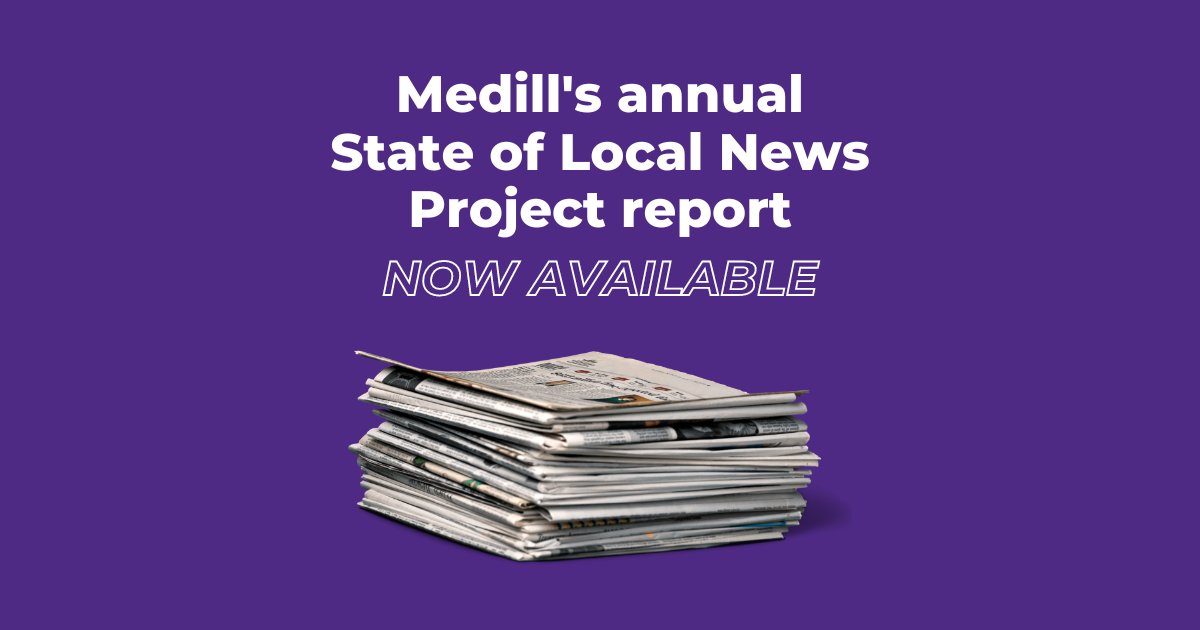[ad_1]
Analysis shows more than 7% of counties at substantial risk of losing news

EVANSTON, ILL. – The loss of local newspapers accelerated in 2023 to an average of 2.5 per week, leaving more than 200 counties as “news deserts” and meaning that more than half of all U.S. counties now have limited access to reliable local news and information, researchers at the Medill School of Journalism, Media, Integrated Marketing Communications at Northwestern University have found.
In addition, Medill researchers for the first time used predictive modeling to estimate the number of counties at risk of becoming news deserts. Those models show that another 228 counties are at high risk of losing local news. In creating that “Watch List,” Medill researchers and data scientists applied the characteristics of current news deserts to counties with only one news source.
Medill’s annual “State of Local News Project” report also counts about 550 digital-only local news outlets, 700 ethnic media organizations and 225 public broadcasting stations producing original local news. Most of the digital-only startups are based in metro areas, exacerbating the divide in America between news-haves and have-nots.
Also new this year, the State of Local News Project, in partnership with Microsoft, generated a “Bright Spots” map showing all local news startups in the U.S. as they’ve appeared over the past five years. The map also highlights 17 local news outlets — both startups and legacy organizations — with promising new business models for the future.
“The significant loss of local news outlets in poorer and underserved communities poses a crisis for our democracy,” said Medill visiting professor Penny Abernathy, a co-author of this year’s report who has been studying local news deserts for more than a decade. “So, it is very important that we identify the places most at risk, while simultaneously understanding what is working in other communities.”
Here are some of the report’s key findings:
- There are 204 counties with no local news outlet. Of the 3,143 counties in the U.S., more than half, or 1,766, have either no local news source or only one remaining outlet, typically a weekly newspaper.
- The loss of local newspapers ticked higher in 2023 to an average of 2.5 per week, up from two per week last year. There were more than 130 confirmed newspaper closings or mergers this past year.
- Since 2005, the U.S. has lost nearly 2,900 newspapers. The nation is on pace to lose one-third of all its newspapers by the end of next year. There are about 6,000 newspapers remaining, the vast majority of which are weeklies.
- The country has lost almost two-thirds of its newspaper journalists, or 43,000, during that same time. Most of those journalists were employed by large metro and regional newspapers.
- There are about 550 digital-only local news sites, many of which launched in the past decade, but they are mostly clustered in metro areas. In the past five years, the number of local digital startups has roughly equaled the number that shuttered.
- Based on the demographics and economics of current news desert counties, Medill’s modeling estimates that 228 counties are at an elevated risk of becoming news deserts in the next five years. Most of those “Watch List” counties are located in high-poverty areas in the South and Midwest, and many serve communities with significant African American, Hispanic and Native American populations.
The predictive modeling analysis was conducted by faculty, researchers and staff of the Medill Local News Initiative and the Spiegel Research Center using demographic, economic and local news data from every county in the U.S.
“We are at a moment of great loss but also great possibility for local journalism,” said Sarah Stonbely, the other co-author of the report and the director of the State of Local News Project. “With new data capabilities and an increased recognition of the importance of local news, our goal is to build on the foundation laid by Penny Abernathy to continue to provide vision and insight into this vitally important space.”
Tim Franklin, who directs the Medill Local News Initiative and serves as the John M. Mutz Chair in Local News, said this year’s report is especially significant because it illustrates for the first time the counties most in danger of losing local news. That gives leaders in those counties, philanthropists, investors and policymakers an opportunity to act before a news desert is created.
“In addition to documenting the current state of play, we wanted to make the report more forward looking and diagnostic this year,” said Franklin, who also serves as Medill’s senior associate dean. “The new ‘Watch List’ counties and ‘Local News Ecosystem Barometer’ maps provide valuable context, especially for policymakers and philanthropists working to address the local news crisis going forward.”
At the same time, Franklin said this year’s report provides some optimism for the future. “With our ‘Bright Spots’ map, we’re able to highlight where local news growth has occurred, and we profiled in detail 17 news outlets that are providing inspiration through new models for news.”
That map was supported by a gift from Microsoft and crafted by the team at Enlighten Designs in New Zealand.
“Healthy local news ecosystems are essential to thriving democracies,” said Ginny Badanes, senior director of Microsoft’s Democracy Forward program. “Microsoft supports local journalism initiatives, and this important research about the state of the industry, as part of its commitment to supporting democracy. This is a story of hope about how critical infrastructure in local news is rebounding.”
The State of Local News Project is one of six programs under the umbrella of the Medill Local News Initiative, a research and development project aimed at bolstering the sustainability of local news.
The State of Local News Project is funded with grants and gifts from the Knight Foundation, MacArthur Foundation, Joyce Foundation, Lilly Endowment, Microsoft, Myrta J. Pulliam Charitable Trust, the Southern Newspaper Publishers Association Foundation and Medill alumnus Mark Ferguson.
[ad_2]
Source link
